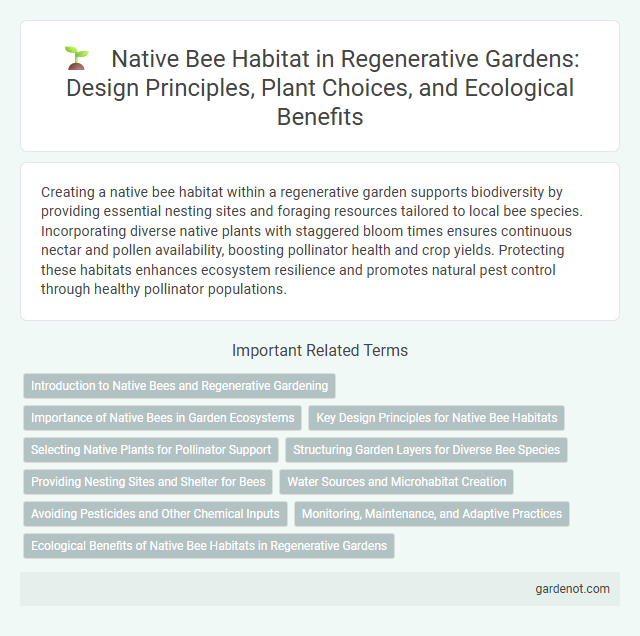Creating a native bee habitat within a regenerative garden supports biodiversity by providing essential nesting sites and foraging resources tailored to local bee species. Incorporating diverse native plants with staggered bloom times ensures continuous nectar and pollen availability, boosting pollinator health and crop yields. Protecting these habitats enhances ecosystem resilience and promotes natural pest control through healthy pollinator populations.
Introduction to Native Bees and Regenerative Gardening
Native bees, including species like carpenter, mason, and sweat bees, play a crucial role in regenerative gardening by enhancing pollination and biodiversity. These solitary bees thrive in habitats with diverse, pesticide-free flowering plants and natural nesting sites such as bare soil, dead wood, or hollow stems. Integrating native bee habitats into regenerative gardens supports ecosystem health, improves crop yields, and sustains native plant communities.
Importance of Native Bees in Garden Ecosystems
Native bees play a crucial role in garden ecosystems by enhancing pollination efficiency, which directly supports plant biodiversity and fruit production. Their specialized behaviors and native plant preferences contribute to sustaining local flora and maintaining ecosystem balance. Protecting native bee habitats in regenerative gardens fosters resilient, productive environments while promoting natural pest control and soil health.
Key Design Principles for Native Bee Habitats
Key design principles for native bee habitats include providing diverse flowering plants that bloom sequentially from early spring to late fall to ensure continuous food sources. Incorporating undisturbed bare soil patches and hollow stems supports essential nesting sites for ground-nesting and cavity-nesting bees. Avoiding pesticides and maintaining habitat connectivity enhances bee survival and promotes pollination within regenerative garden ecosystems.
Selecting Native Plants for Pollinator Support
Selecting native plants such as milkweed, coneflowers, and goldenrod enhances native bee habitat by providing essential nectar and pollen sources throughout the growing season. These plants support local pollinator species by offering suitable foraging opportunities and nesting materials that align with their ecological needs. Incorporating a diverse array of native flora increases pollinator diversity and promotes a resilient regenerative garden ecosystem.
Structuring Garden Layers for Diverse Bee Species
Structuring garden layers to support native bee habitats involves planting a variety of flowering plants at different heights, including ground covers, shrubs, and canopy trees, to provide continuous forage throughout the seasons. Incorporating native wildflowers and nesting materials like hollow stems or bare soil encourages diverse bee species such as bumblebees, leafcutter bees, and mason bees to thrive. This multi-layered approach enhances biodiversity and promotes resilient pollination networks essential for regenerative garden ecosystems.
Providing Nesting Sites and Shelter for Bees
Creating a regenerative garden by providing diverse nesting sites and shelter supports native bee populations, which play a crucial role in pollination. Incorporate features like hollow stems, dead wood, bare soil patches, and bee hotels to mimic natural habitats. These structures enhance bee biodiversity, improve ecological balance, and increase plant productivity in sustainable gardening practices.
Water Sources and Microhabitat Creation
Native bee habitat in regenerative gardens relies heavily on accessible water sources such as shallow ponds, dripping stones, or damp soil patches to meet hydration needs. Microhabitat creation involving varied ground conditions, including exposed bare soil, leaf litter, and undisturbed wood, fosters nesting and foraging opportunities essential for native bee survival. Integrating diverse plant species and structural elements enhances moisture retention and microclimate stability, optimizing the habitat for native pollinators.
Avoiding Pesticides and Other Chemical Inputs
Native bee habitats thrive best in regenerative gardens where pesticides and other chemical inputs are completely avoided, ensuring a safe and healthy environment for pollinators. Minimizing chemical exposure helps maintain soil biodiversity and promotes the natural pest control mechanisms essential for native bees. Implementing organic mulches and companion planting further protects native bee populations by reducing the need for harmful substances.
Monitoring, Maintenance, and Adaptive Practices
Monitoring native bee habitats involves regular assessments of bee population health and floral resource availability to ensure ecosystem balance. Maintenance requires preserving diverse native plant species, managing invasive plants, and providing nesting materials to support bee reproduction. Adaptive practices include modifying planting schedules and habitat structures based on monitoring data to enhance resilience and biodiversity in regenerative gardens.
Ecological Benefits of Native Bee Habitats in Regenerative Gardens
Native bee habitats in regenerative gardens enhance pollination efficiency by supporting diverse plant species, leading to increased crop yields and biodiversity. These habitats improve soil health through natural nutrient cycling and reduce the need for chemical inputs by fostering a balanced ecosystem. Promoting native bee populations also strengthens local resilience against pests and climate variability, ensuring sustainable garden productivity.
Native bee habitat Infographic

 gardenot.com
gardenot.com